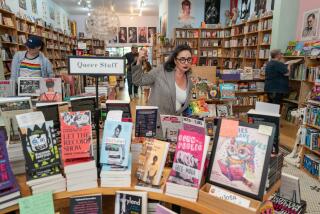How Disney’s onscreen LGBTQ representation could improve with an overlooked Fox asset
Goldie Vance is a mixed-race teenage detective unafraid of breaking a few rules when pursuing leads on a case. She also happens to be queer.
This may not be the kind of protagonist who immediately comes to mind when people talk about comic book movies, but an adaptation of “Goldie Vance,” an all-ages comics series created by Hope Larson and Brittney Williams, was among the projects in Fox’s pipeline when it was announced that Walt Disney Co. would be taking over 20th Century Fox.
Though it’s still in development — with Rashida Jones as the director and Kerry Washington as one of the producers — the “Goldie Vance” adaptation is a particularly notable one to watch following the Disney-Fox merger. Numerous diversity studies point out year after year that women, people of color and members of the LGBTQ community remain underrepresented in Hollywood movies and TV. Indeed, GLAAD’s 2018 Studio Responsibility Index found that LGBTQ representation in Hollywood films reached a six-year low in 2017, and Walt Disney Studios had the weakest history of representation out of all the studios tracked for the report.
Since its acquisition of Marvel Entertainment in 2009, Disney has made its mark in comic book films, so it’s understandable that superhero movie enthusiasts immediately wondered how the Disney-Fox deal would affect future tentpoles involving Deadpool, the X-Men and the Fantastic Four.
FULL COVERAGE: Everything you need to know about Disney’s Fox acquisition »
But Fox’s comic book arsenal extends beyond the characters inhabiting its corner of Marvel’s universe. It also includes “Goldie Vance” and an array of original titles and buzzy licensed comics from L.A.-based publisher Boom! Studios. Some of those titles could help Disney improve its LGBTQ representation onscreen.
At the moment, there are 11 Boom! Studios titles in various stages of development at Fox. One of those, a full CGI feature adaptation of the Eisner Award-winning series “Mouse Guard” from director Wes Ball, is scheduled to start production in May with Andy Serkis and Thomas Brodie-Sangster in the leads. And in addition to “Goldie Vance,” a movie adaptation of Boom!’s “Lumberjanes,” which includes queer and transgender characters among its leads, was announced by Fox in 2015. The series, about the supernatural adventures of girls at summer camp, has been hailed for its inclusion and fun storytelling.
Across Boom!’s four imprints, readers can find books about young cadets piloting giant robots from outer space to defend Earth, students and teachers of a prep school who suddenly find themselves on an alien moon, and even the professional wrestlers of the WWE.
“Boom! Studios was brought into Fox four years ago by Co-Chairman Emma Watts as an idea and IP pipeline to supply the studio with new franchises,” says Stephen Christy, Boom! Studios’ president of development. “What was originally a first-look relationship between Boom! and Fox evolved into the studio taking a minority ownership stake in the publisher in 2017.”
Fox’s stake in Boom!, which was founded in 2005 by Ross Richie and Andrew Cosby, will be transferred to Disney. But the two companies have their own history. Boom! briefly published some of Disney’s licensed comics.
While “Mouse Guard” is slated for a theatrical release, some other titles from Boom’s lineup of all-ages comics seem primed to be among Fox’s offerings to the upcoming Disney+ streaming service.
A number of these original titles would easily appeal to a wider Disney audience, but one of the ways the two companies diverge is in their track record when it comes to LGBTQ representation.
“We believe comic books are for anyone, so we make them for everyone,” says Arune Singh, Boom! Studios’ vice president of marketing. “We’re looking for stories that reflect the stories and experiences of the people who read our comics, so when a creator can bring us that — even if it’s in a fantastical setting — it’s appealing for us.”
Singh says that Boom! strives to publish passion projects that are reflective of the real world and can appeal to all types of readers, including those new to the medium.
“We don’t believe you can achieve these goals if you don’t bring in new voices from every walk of life,” Singh says. “As a result, our publishing line organically reflects diversity, and the comics and graphic novels are often created by underrepresented voices.”
This diversity includes LGBTQ representation both on and beyond the page. A number of Boom! titles have been recognized at the GLAAD Media Awards in recent years, with “Lumberjanes” and “The Woods” winning outstanding comic book in 2016 and 2017, respectively. Other comics from the publisher that have been nominated include “Goldie Vance,” “Memetic,” “The Backstagers” and “Fence.”
In fact, an uptick in good, LGBTQ-inclusive comics in recent years throughout the industry led to GLAAD increasing the number of nominees in the category.
On the other hand, its Studio Responsibility Index showed that of the eight films released by Walt Disney Studios in 2017, just “one included appearances by LGBTQ people.” For the study, GLAAD examines “if an identifiably LGBTQ character is present in the film at all, if they have an impact on the plot and if they are defined by more than just their sexual orientation or gender identity,” says Megan Townsend, GLAAD’s director of entertainment research.
This means characters who are implied to be LGBTQ through subtext or confirmed off-screen from filmmakers don’t count toward representation for the purposes of GLAAD’s report.
Despite any on-screen cues or the actual LGBTQ people who had a hand in building Disney’s family-friendly empire, the studio’s efforts to nurture this image has meant shying from anything that could be perceived as “edgy” or “controversial,” resulting in a dearth of characters who are “identifiably LGBTQ.”
“Far too often, LGBTQ characters and stories have been relegated to subtext or coding that the audience is left to interpret,” Townsend says. “When the only stories that queer people could see themselves in used this kind of indirect expression, it sent a message to LGBTQ audiences that we had to hide ourselves and showed others that LGBTQ people should be hidden.”
But there are signs that Disney has been shifting to be more inclusive. The first Disney movie to include an “exclusively gay moment” was 2017’s “Beauty and the Beast” (despite some calling the moment a bit lackluster). Disney has made further strides on TV by featuring its first coming-out storyline in “Andi Mack,” which has included the young character saying the words “I’m gay” (another Disney first).
It seems that even Marvel is readying to introduce a gay superhero to its cinematic universe.
Boom! Studios’ library gives Disney the potential to bring even more LGBTQ-inclusive stories such as “Goldie Vance” and “Lumberjanes” to screens big and small as long as these adaptations remain true to how characters identify in the source material.
Twitter: @tracycbrown
More to Read
The biggest entertainment stories
Get our big stories about Hollywood, film, television, music, arts, culture and more right in your inbox as soon as they publish.
You may occasionally receive promotional content from the Los Angeles Times.











